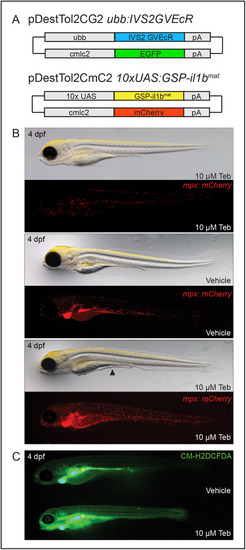
Genetic induction of ubiquitous GSP-Il-1βmat by the ecdysone mimic tebufenozide produces systemic inflammation. (A) Schematic of DNA constructs injected to make the Tg(ubb:IVS2GVEcR, cmlc2:EGFP) and Tg(UAS:GSP-il1bmat, cmlc2:mCherry) lines. Driver lines and responder lines are distinguished by green (cmlc2:EGFP) or red (cmlc2:mCherry) hearts, respectively. (B) Transgenic larvae, expressing the driver and responder transgenes in the Casper mpx:mCherry background, were induced with vehicle (DMSO) or 10 µM Teb at 2 dpf. Fluorescent stereoscope images taken at 4 dpf show neutrophils spreading throughout Teb-induced larvae, while brightfield images reveal a sickly appearance and degradation of the median fin fold (black arrowhead). Casper mpx:mCherry larvae exposed to 10 µM Teb and vehicle exposed Casper mpx:mCherry larvae positive for both driver and responder transgenes appear normal; n=20 for each condition. (C) Larvae were exposed to vehicle or 10 µM Teb at 2 dpf and examined for the formation of ROS using the cell permeant indicator CM-H2DCFDA at 4 dpf. Larvae from each condition were imaged in the same field by fluorescence stereomicroscopy, revealing heightened ROS production in Teb-induced larvae; n=5 for each condition. The gut rapidly absorbs and forms fluorescent product in both larvae (yellow asterisk).
|